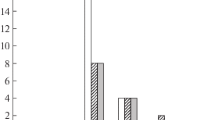Summary
In mice infected intraperitoneally with a hundred per cent lethal dose of West Nile virus a significant reduction in mortality was found if treatment with the complex of synthetic polyriboinosinic and polycytidylic acids (Poly I∶C) was given four hours prior to or twenty hours after virus challenge.
Treatment induced large amounts of circulating interferon a few hours after inoculation. Only a slight difference in maximum viraemia in the various groups was found, but viraemia developed later in the mice given Poly I∶C a few hours before virus injection. Infection of the brain developed later in the groups treated with Poly I∶C.
Using various doses of West Nile virus almost the same mortality was found in the group given a lethal virus dose but treated with Poly I∶C and the group receiving sublethal virus dose and no Poly I∶C treatment. Maximum of viraemia was high in the former group, while in the latter group it was significantly lower. Therefore it is supposed that Poly I∶C in these experiments did not protect through an interferon mediated suppression of the viraemia but rather through an effect of the interferon exerted directly upon the target organ. A reduction of circulating HI antibodies was found in the group on which Poly I∶C had the most pronounced effect.
Similar content being viewed by others
References
Baron, S.,et al.: Role of interferon during viraemia. II. Protective action of circulating interferon. J. Immunol.96, 17–24 (1966).
Fantes, K. H.: Purification, concentration and physico-chemical properties of interferons. In: Interferons. (N. B. Finter, ed.) North Holland Publishing Company, Amsterdam. 119–180 (1966).
Field, A. K.,et al.: Inducers of interferon and host resistance. II. Multistranded synthetic polynucleotide complexes. Proc. nat. Acad. Sci. (Wash.)58, 1004–1010 (1967).
Finter, N. B.: Interferon as an antiviral agentin vivo: Quantitative and temporal aspects of the protection of mice against Semlike Forest virus. Brit. J. exp. Path.47, 361–371 (1966).
Finter, N. B.: Protection of mice by interferon against systemic virus infections. Brit. med. J.II, 981–985 (1964).
Gresser, I.,et al.: A comparison of the efficacy of endogenous, exogenous, and combined endogenous-exogenous interferon in the treatment of mice infected with encephalomyocarditis virus. Proc. Soc. exp. Biol. (N.Y.)130, 236–242 (1969).
Gresser, I.,et al.: The effect of interferon on infection of mice with encephalomyocarditis virus. In: The Interferons pp. 197–201 (G. Rita, ed.) New York and London: Academic Press, 1968.
Haahr, S.: The occurrence of virus and interferon in the spleen, serum and brain in mice after experimental infection with West Nile virus. Acta path. microbiol. scand.74, 445–457 (1968).
Haahr, S.: The occurrence of virus and interferon in spleen, serum and brain in steroid-treated mice under experimental infection with West Nile virus. Acta path. microbiol. scand.75, 303–312 (1969).
Irwin, J. O., andE. A. Cheeseman: On an approximate method of determining the median effective dose and its error in the case of a quantal response. J. Hyg. (Lond.)39, 574–580 (1939).
Kunz, Ch., undH. Hofmann: Die Beeinflussung der experimentellen Frühsommer-Meningoenzephalitis (FSME)-Virusinfektion durch die Interferon induzierende Substanz Poly I∶C. Zbl. Bakt., I. Abt. Orig.211, 270–273 (1969).
Kärber, G.: Beitrag zur kollektiven Behandlung pharmakologischer Reihenversuche. Arch. exp. Path. Pharmak.162, 480–496 (1931).
Rabson, A. S.,et al.: Inhibition of human cytomegalovirusin vitro by doublestranded polyribocytidylic-inosinic acid (Poly Ir·Cr). Proc. Soc. exp. Biol. (N.Y.)131, 495–497 (1969).
Vilcek, J.,et al.: Induction of interferon synthesis by synthetic double-stranded polynucleotides. J. Virol.2, 648–650 (1968).
Youngner, J. S., andJ. V. Hallum: Interferon production in mice by double-stranded synthetic polynucleotides: induction or release? Virology35, 177–179 (1968).
Author information
Authors and Affiliations
Rights and permissions
About this article
Cite this article
Haahr, S. The influence of Poly I∶C on the course of infection in mice inoculated with West Nile Virus. Archiv f Virusforschung 35, 1–9 (1971). https://doi.org/10.1007/BF01249747
Received:
Issue Date:
DOI: https://doi.org/10.1007/BF01249747



